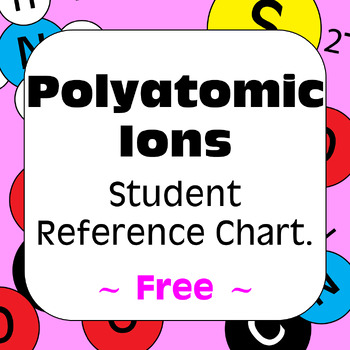- PDF
- Easel Activity
Also included in
- The complete bundle of practice worksheets & assessment quizzes for ionic nomenclature mastery! Comprehensive and, with a variety of print & digital resources, it provides plenty of options to choose from depending on your teaching needs. A total of 158 different ionic compounds:All compoundPrice $17.77Original Price $19.75Save $1.98
- The complete bundle of practice worksheets & assessments for covalent nomenclature mastery! Comprehensive and, with a variety of print & digital resources, it provides plenty of options to choose from depending on your teaching needs. A total of 110 different covalently bonded compounds:AllPrice $12.38Original Price $13.75Save $1.37
- The complete bundle of practice worksheets & assessments for ternary/polyatomic nomenclature mastery! Comprehensive and, with a variety of print & digital resources, it provides plenty of options to choose from depending on your teaching needs. A total of 132 different ternary/polyatomic comPrice $15.30Original Price $17.00Save $1.70
- The complete bundle of practice worksheets & assessments for ionic, ternary/polyatomic, and covalent nomenclature mastery! Comprehensive and, with a variety of print & digital resources, it provides plenty of options to choose from depending on your teaching needs. A total of 150 different iPrice $15.30Original Price $17.00Save $1.70
- The ultimate bundle of practice worksheets and assessment quizzes for chemical nomenclature mastery!Comprehensive and, with a variety of print & digital resources, it provides plenty of options to choose from depending on your teaching needs.550 different compounds.8 practice worksheets (print &Price $60.75Original Price $67.50Save $6.75
Description
Polyatomic ion reference sheet containing 33 polyatomic ions sorted by name and by formula.
- IUPAC-recommended spelling is used.
- 3 sizes to choose from.
- Pages uploaded to Easel for easy digital access.
Includes the following polyatomic ions:
Acetate, Ammonium, Arsenate, Arsenite, Benzoate, Borate, Bromate, Carbonate, Chlorate, Chlorite, Chromate, Cyanate, Cyanide, Dichromate, Dihydrogen phosphate, Hydrogencarbonate, Hydroxide, Hypochlorite, Iodate, Nitrate, Nitrite, Oxalate, Perchlorate, Permanganate, Peroxide, Phosphate, Silicate, Stearate, Sulfate, Sulfite, Tetraborate, Thiocyanate, & Thiosulfate.
Designed to accompany the following chemical nomenclature activities:
Compounds with Ternary/Polyatomic Ions
- Practice worksheets & assessments containing a total of 132 different ternary/polyatomic compounds (digital & print).
Mixed Ionic, Polyatomic, & Covalent Compounds
- Practice worksheets & assessments containing a total of 150 different ionic, ternary/polyatomic, and covalent compounds (digital & print).
- Practice worksheets & assessments containing a total of 158 different ionic compounds (digital & print).
- Practice worksheets & assessments containing a total of 110 different covalently bonded compounds (digital & print).
Click here to follow my store and receive the latest updates.
Original Artwork (©AwesomeScience). For Personal Use Only. Uneditable.
Page count does not include Terms of Use and links to supplementary activities.
Copyright ©AwesomeScience 2013 – The Present.
All Rights Reserved by Author.
By using this Resource you agree to the Terms as outlined in the Terms of Service. This Resource is for limited Personal Use only; not to be used, in part or in whole, for commercial purposes. Each Individual License is for use by one specific educator only. Additional licenses must be purchased for each additional educator. Except as permitted in Section 3 to deliver Resources electronically to Permitted Recipients, you may not post or otherwise make the Resource available on any website, application, shared drive or other sites or services.











